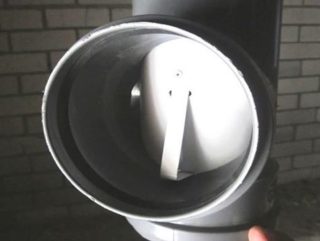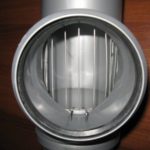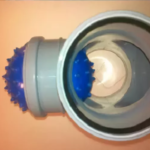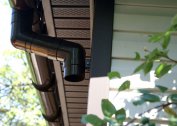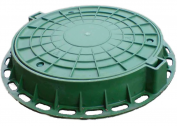Management companies use tough methods to deal with public service debts. To force people to pay water bills, they block the sewer using special plugs. But if there is no money for a communal apartment yet, you can remove the device yourself, and quite legally.
Purpose of a stub for debtors
If a person does not pay for the supply of water in a timely manner, it is quite reasonable to stop supplying him this utility service. However, in apartment buildings, the liquid is supplied through a common house riser, which means that it will be necessary to completely shut it off. But after all, respectable payers live in the entrance.
It is possible to stop the water supply for a certain apartment only inside it, but the owner has the legal right not to let controllers come to him.
Utility experts found a solution - to block sewer pipes to debtors. This is real for a separate apartment and is accomplished through a plug - a valve that closes the drain hole between the common house riser and a private drainage network.
Installing an silencing part will not cause problems for respectable residents. It is set so that the sewage system is blocked only for a certain apartment. Typically, the installation of the device leads to the fact that debts are paid after two to three days. After this, the public utilities return the riser to its former appearance. However, there are exceptions. For various reasons, homeowners decide to remove the plug themselves - there are plenty of methods for this.
Legality of installation and self-removal of plugs
In general, the installation of such devices is not against the law. However, before installation, the management company must send a letter notifying them of the restriction of wastewater services so that the owner becomes aware of upcoming problems. The most savvy defaulters, having received such a document, prevent the installation of a plug valve. They put an anti-plug on the sewer pipe. For these purposes, a through stud or bolt is used. The anti-plug is inserted slightly above the tee and prevents the valve from being mounted.
If a warning to the landlord has not been made, the legality of installing a plug on the sewer riser for debtors can be challenged in court.
It’s easier and faster to simply remove the interfering device. In matters of the legality of such actions, the law is on the side of the residents. After all, the valve creates a blockage in the sewage system, which must be eliminated.
Experienced defaulters recommend not to remove the plug immediately after its appearance, but to wait until the pipe clogs a little. After that, the legality of actions to clean it will be undeniable.
Types of devices and principle
Sewerage is blocked using three types of valves:
- Solid. Such valves completely block the drain flow into the central sewer.
- Trellised. They allow liquid runoff, and solid waste accumulate on the surface.
- Pneumatic plugs. The pipeline is completely shut off by pumping the device with compressed air, which after that looks like a rubber ball.
- Trellised plug
- Solid lock
- Pneumatic plug
It is difficult to say which valve will be installed by housing and communal services specialists. It depends on the layout of the highway and the financial capabilities of the management company. Solid plastic valves have the lowest price, so they are more likely to be installed.
Valve installation
 The plumber conducts this manipulation after carefully studying the piping scheme throughout the riser and directly wiring to the debtor's living space.
The plumber conducts this manipulation after carefully studying the piping scheme throughout the riser and directly wiring to the debtor's living space.
Further actions are as follows:
- Conducting accurate calculations of the location of the drain from the apartment.
- Lowering from the roof of the manipulator with a fixed plug into the desired hole in the general sewer riser.
- Finding the necessary "fork" through the monitor and LED.
- Insert the plug into the side opening of the system.
After that, it remains to get equipment from the pipeline and report to the authorities, and the management of the Criminal Code to wait for the debtor to come to pay the bills. Only after this, the public utilities will remove the plug from the sewer riser if the landlord does not solve the problem himself.
Removal Methods
The easiest option to get rid of the problem is to pay bills. After that, the public utilities will remove the stub. But even after payment there is no guarantee that the plumber will come on the same day. It is not known how long it will have to be expected, and the blockage in the pipe will be aggravated, exuding stench. Therefore, those who paid the debt also sometimes decide to remove the blank from their sewers on their own. For this, the same methods are used as for the elimination of blockages.
Removal by plunger and plumbing cable
Using these tools is the easiest way to remove the plug yourself. To do this, determine its location. This can be found by tapping pipes. A muffled sound speaks of filled places, and a loud sound speaks of empty ones.
Then proceed as follows:
- Open the water in the plumbing fixture closest to the valve and wait until it reaches the drain.
- Install the plunger over the drain grate.
- Do a few pumping to create increased pressure in the pipeline. Water does not compress, which will push the plug out of the pipe.
If the valve is not installed too well, the valve is enough to solve the problem. But the part may get stuck in the main pipe, after which all residents will not be able to use the sewage system.
If the problem is not solved by a plunger, you can use a plumbing cable. This is an ideal method to handle a pneumatic valve. A hole is made in it, into which the hook is inserted. With little effort, the fixture is removed from the pipeline. However, it is easy to hook and pull out the grill with a hook.
Dismantling the toilet
The use of this method is possible only if the plumbing is fixed to the floor by means of bolts. If the toilet is an old model, the installation of which was carried out on a cement-sand mortar, this option disappears due to inexpediency, unless a replacement is planned. After dismantling, installing plumbing in place simply does not work.
Dismantling is as follows:
- Turn off the water supply.
- Remove the reservoir and disconnect all communications.
- Unscrew the bolts, move the toilet bowl and get to the conclusion to the common riser. Typically, the location of the tap allows you to reach the inserted plug and remove it. If the obstacle is not far from the entrance to the inter-apartment pipeline, it is pulled out by grabbing with pliers.
It is strictly forbidden to push the plug into the common riser, as this will aggravate the problem. A part can clog a common pipe and create a problem not only with communal services, but also with neighbors. Therefore, the barrier on the way of sewage should be removed only to your apartment.
If a cement mortar was used when installing the toilet, but there is a revision door nearby for cleaning the pipeline, you can use it. Removing the plug will be more difficult. To remove the barrier, you will need a plumbing harpoon or a regular long stick with a hook fixed to the end.
The procedure is as follows:
- Open the revision.
- Insert the prepared hook or harpoon.
- Pick up the plug.
- Push her into the riser.
Before that, you should worry about your safety. You need to wear a warm shirt and rubber gloves, after wrapping your hands in polyethylene over your shoulders. From the neighbors, not only feces, but also boiling water can descend from above in the process of work.
It is not difficult to pull out a part from polypropylene or mesh, but this technique has a number of imperfections. There is a danger of dropping the broken plug and blocking the common riser with it. The difficulty is that all actions are performed blindly.
Chemical cleaning
The market of household chemicals represents a wide range of means for cleaning sewers containing hydrochloric or oxalic acid. They can be used to eliminate the stub. This method will bring a minimum of trouble, but the chances of success are much less:
- The compounds act only on metallic species.
- There is a risk that chemistry will corrode not only the barrier, but the pipe itself.
- The result will appear in a few days, or even a week - that is, the elimination of the problem will be postponed.
Plastic continuous valves and pneumatic plugs cannot be eliminated with chemicals. For their manufacture, similar to pipe materials are used. A large volume of "vigorous" chemistry will destroy not only the valve, but also pipes throughout the sewage system. Its repair will result in an amount greater than debts.
If you can’t solve the problem, you can dismantle part of the sewer pipeline and get to the right place. Or seek help from specialists.
Such a service can easily be provided by the same plumber, working in a private manner, since the owner of the house bears all responsibility for the condition of the sewer pipes. Prices for professional removal of the plug from the sewer depend on the complexity of the work. The average cost of removing a part by a specialist is from 500 to 2500 rubles.
Installing a plug for non-payment of a communal apartment is not illegal. But at the same time, such actions can be challenged in court. Independent removal of the barrier is quite a complicated matter - you need to have plumbing skills. It’s easier to pay debts. In addition, it is not worth excluding the fact that after the elimination of the stub, public utilities will install a new one.
